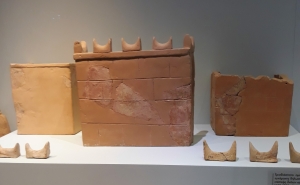The hill Katrinia in the area of Piskokefalo, province Sitia, hosted one of the most important peak sanctuaries of Minoan Crete, where pilgrims from the surrounding areas came to praise their deities and devote their tributes. Three sacred caves have been identified in the same area, just like in other peak sanctuaries in Crete (e.g. Giouchtas, Pirgos near Tylissos, etc.).
Crete is the birthplace of the first European civilization, the Minoan, which flourished between 3000 BC and 1200 BC mainly in Central and Eastern Crete. Even today, the majestic palaces of Knossos, Phaestus, Malia, Zakros, Tylissos, Arhanes, Monastiraki, Galatas, Kydonia and the luxurious mansions at Agia Triada, Zominthos, Amnisos, Makrigialos, Vathipetro and Nerokouros reflect the splendor of the Minoan civilization through architectural, pottery, jewelry and painting masterpieces.
The Minoan fleet, the strongest of its era, as evidenced by several findings in the Mediterranean, brought wealth to Crete from the trade of the famous Cretan cypress and agricultural products. Built in large yards, such as the shipyard of Agii Theodori at Vathianos Kambos, ships were loaded with timber, honey, wine, pottery and olive oil from the ports of Dia, Katsambas, Komos, Zakros, Psira, Mochlos, Niros, Petras, sailing towards all directions of the Mediterranean as far as Scandinavia.
Women were equal to men and took part in all religious ceremonies, in sports, hunting, theater, dance, etc. Masterpieces of building architecture, painting, sculpture and goldsmithing continue to inspire even modern civilization. Linear A and Linear B Scripts remind of the Egyptian hieroglyphics, but they were original Greek scripts. Even today, the disc of Phaestus is one of the most famous mysteries of archeology and deciphering of its symbols remains a riddle.
The worship of deities such as the Mother Goddess of fertility, the Mistress of the Animals, protector of cities, the household, the harvest, and the underworld dominated the religious tradition of the Minoans, who used many caves and mountain peaks as places of worship. Pilgrims from all over the island ascended to the peak sanctuaries of Youchtas and the cave of Hosto Nero to offer their votives, such as Minoan inscriptions or clay idols. Peak sanctuaries were also hosted atop summits Kofinas, Vrysinas, Petsofas, Traostalos, Karfi, etc. The Diktaean, Idaean and Kamares Caves also played a prominent role in the worship of gods.














































































